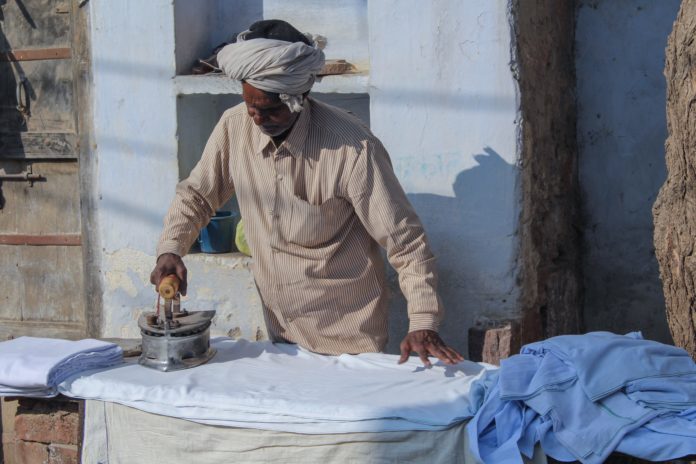With patches, you can hide unwanted holes and tears on your jacket, jeans, or shirt. No matter what, you can use iron-on or sew-on patches, as per your choice. Previously, people use patches formally, but now you can see many everyday uses of different patches.
Undoubtedly, patches give a trendy look to your outfit, and it shows another side of your personality to the world. Well, the main problem comes when you are stuck between choosing iron on patches and sewing on patches. Both kinds of patches have several features, and you can use them accordingly.
What do you think is it better to sew or iron on a patch?
Let’s find out.
Keep in mind three things depending on the material you tend to use for patching:
· Iron-On
· Glue
· Sewing
It all depends on you, whether you choose only one or a combo of the above-mentioned options. Well, some people use more than one option for patches’ longevity. We’ll have a quick view of the simple process.
If you have a short time and want to give your outfit a fantastic look, the iron-on patch is the ultimate thing. For this process, you need an iron and a piece of cloth. Place the patch where you want to stick it, covering it with a cloth. Set the iron to the maximum temperature and place it on the patch.
Continue ironing and stick it firmly. Typically, iron-on patches stick on for almost 25 washes, and it is enough for an outfit to keep up. On the other hand, you need to sew it on for the long life of the patch.
Bonus Tip: Don’t sew on the small plastic backing while sewing an iron-on patch on your bag or jeans.
Do you know the iron-on patch is way stronger than sew-on patches?
Also, you can use them as per your choice without losing their shapes.
Iron-On Patches
Basically, iron-on patches can be attached to any cloth using an iron or heat. People use these patches because they are easy to apply, and you don’t need any material other than iron. Having a sticky surface from the backside makes the patch easy to attach after applying heat. Some patches come up with a removable backing sheet, and some patches just have a sticky back.
Bonus Tip: Having difficulty is sewing through the layer of glue? A Wedge needle is the best solution in that case because it can pass on to the glued layer easily.
How to Apply an Iron-On Patch?
Following the below-given steps, you can easily attach an iron-on patch.
· Hold the patch firmly over the piece of cloth.
· Set the iron at the maximum temperature according to the fabric and wait for it.
· Place the iron on your patch (while covering the hole, if any).
· On the backside of the patch, spraying a little bit of water would make it fix properly.
· Put a towel or a piece of cloth over the patch to avoid overheating and damage the patch and outfit.
· Continue pressing the iron over the towel consistently. You may need to iron for almost 30 seconds.
Bonus Tip: Try not to stick iron-on patches on nylon, leather, elastic fabric, and waterproof or rainwear fabrics. Heating can damage these kinds of cloth.
Sew-On Patches
So, what are sew-on patches? Are there any differences between iron-on and sew-on patches?
Sew-on patches are ordinary patches with or without embroidery. You will not feel them flexible because there is no backing sheet on the backside. Iron-on patches usually never bend with the fabric because of the glued layer, whereas sew-on patches constantly adjust with the fabric.
How to Apply a Sew-On Patch?
Sewing patches on clothes tends to be considered harder than ironing. Do you think sewing is tricky? Well, to be honest, most youngsters think sewing patches make their outfits cool and trendy. With sew-on patches, you can cover the holes on the jacket or jeans and enhance the beauty of your outfit.
No matter what piece of your outfit needs alteration, you can put sew-on patches quickly. Even your iron-on patches can get sued if you don’t like ironing. While aggressive washing or a hit by the road, you can have tears or damage to the outfit. And ultimately, it gets altered using a patch, whether it be an iron-on or a sew-on patch.
Patches are now everywhere; you can use them on bags, jeans, shirts, jackets, hats, or even on your coats. As they give you an admiring look, you will love it anyway.
To Sum Up
Multiple brands and organizations design a huge range of patches for their team members to dress. Now, you have a complete understanding of iron-on and sew-on patches. So, you can eventually find out what patches are suitable for your fabric.
Some patches need iron to stick on, while others need to stitch on the cloth for more extended application. In my opinion, sew-on patches are the best to use for any fabric because it might be possible that the glued layer gets dry and your iron-on patch falls somewhere on the way.
You may have to bear different situations in case of having third-class iron-on patches stick on the outfit. On the other side, sewing on a patch clearly protects your dress from heat damage and fully locks the beauty of your outfit.











